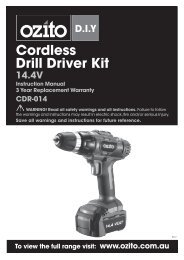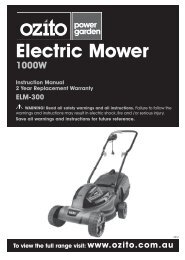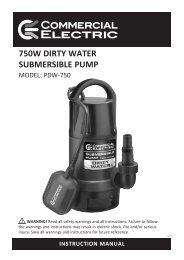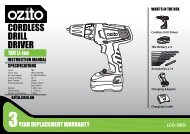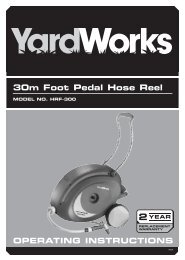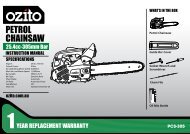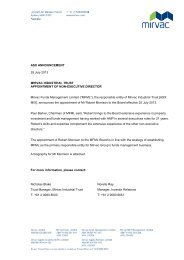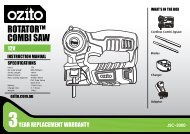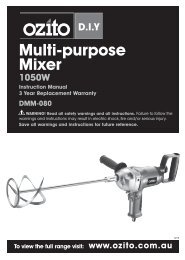Create successful ePaper yourself
Turn your PDF publications into a flip-book with our unique Google optimized e-Paper software.
<strong>Cordless</strong><br />
<strong>Hammer</strong> <strong>Drill</strong> <strong>Kit</strong><br />
18V<br />
Instruction Manual<br />
3 Year Replacement Warranty<br />
CDR-018<br />
WARNING! Read all safety warnings and all instructions. Failure to follow<br />
the warnings and instructions may result in electric shock, fire and/or serious injury.<br />
Save all warnings and instructions for future reference.<br />
To view the full range visit: www.ozito.com.au<br />
0112
Specifications - model no. CDR-018<br />
Motor:<br />
18V<br />
Charge time:<br />
3 – 5 hours<br />
No load speed:<br />
0 – 350 / 0 – 1,100/min<br />
Impact Rate:<br />
0 – 4,550 / 0 – 13,650 bpm<br />
Torque Setting: 18 + 1<br />
Chuck:<br />
10mm Keyless<br />
Max. Torque:<br />
18Nm<br />
Gearbox:<br />
2 Speed<br />
<strong>Hammer</strong> Function: Yes<br />
Batteries:<br />
2 x 18V Ni-Cad<br />
Weight with 1 battery: 2.0kg<br />
KNOW your Product<br />
1<br />
2<br />
3<br />
4<br />
5<br />
9<br />
6<br />
7<br />
8<br />
1<br />
1. Keyless chuck<br />
2. Torque adjustment collar<br />
3. Gearbox speed selector<br />
4. Forward/reverse lever<br />
5. LED light<br />
6. Variable speed trigger<br />
7. Battery release button<br />
8. 18V Battery<br />
9. Charging adaptor<br />
10. Charging jack<br />
11. Charging cradle<br />
11<br />
10
TABLE OF CONTENTS<br />
SPECIFICATIONS ……………………………………….. Page 1<br />
INTRODUCTION………………………………………… Page 3<br />
ELECTRICAL SAFETY…………….……………………… Page 3<br />
GENERAL POWER TOOL SAFETY WARNINGS……… Page 4<br />
BATTERY AND CHARGER SAFETY WARNINGS…….. Page 6<br />
ADDITIONAL SAFETY WARNING FOR<br />
HAMMER DRILLS......................................................... Page 7<br />
CHARGING THE BATTERY…………………………….. Page 8<br />
INSTALLING OR REMOVING THE BATTERY………… Page 9<br />
HAMMER DRILL OPERATION…………………………. Page 10<br />
MAINTENANCE…………….…………………………… Page 14<br />
SPARE PARTS …………….……………………………... Page 14<br />
DESCRIPTION OF SYMBOLS …………………………. Page 15<br />
PACK CONTENTS ……………………………………… Page 16<br />
WARRANTY……………………………………………… Page 17<br />
2
INTRODUCTION<br />
Congratulations on purchasing an Ozito <strong>Cordless</strong> <strong>Hammer</strong><br />
<strong>Drill</strong>. We aim to provide quality tools at an affordable price.<br />
We hope you will enjoy using this tool for many years. Your<br />
<strong>Cordless</strong> <strong>Hammer</strong> <strong>Drill</strong> CDR-018 has been designed to drill<br />
masonry, metal, plastic and for screw driving. It is intended for<br />
DIY use only.<br />
electrical safety<br />
WARNING! When using mains-powered equipment, basic safety precautions,<br />
including the following, should always be followed to reduce risk of fire,<br />
electric shock, personal injury and material damage.<br />
Read and understand the manual prior to operating this tool.<br />
Save these instructions and other documents supplied with this tool for future reference.<br />
This tool is double insulated in accordance with AS/NZS 60335-1; therefore<br />
no earth wire is required.<br />
If the supply cord is damaged, it must be replaced by a qualified electrician or a<br />
power tool repairer in order to avoid a hazard.<br />
Note: Double insulation does not take the place of normal safety precautions when<br />
operating this tool. The insulation system is for added protection against injury resulting<br />
from a possible electrical insulation failure within the tool.<br />
Using an Extension Lead<br />
Always use an approved extension lead suitable for the power input of this tool.<br />
Before use, inspect the extension lead for signs of damage, wear and ageing.<br />
Replace the extension lead if damaged or defective.<br />
When using an extension lead on a reel, always unwind the lead completely. Use of<br />
an extension lead not suitable for the power input of the tool or which is damaged or<br />
defective may result in a risk of fire and electric shock.<br />
It is recommended that the extension lead is a maximum of 25m in length. Do Not<br />
use multiple extension leads<br />
3
general Power Tool Safety Warnings<br />
WARNING! Read all safety warnings and all instructions. Failure to<br />
follow the warnings and instructions may result in electric shock, fire<br />
and/or serious injury.<br />
Save all warnings and instructions for future reference.<br />
The term “power tool” in all of the warnings refers to your mains-operated<br />
(corded) power tool or battery-operated (cordless) power tool.<br />
1) Work area safety<br />
a) Keep work area clean and well lit. Cluttered or dark areas invite accidents.<br />
b) Do not operate power tools in explosive atmospheres, such as in the<br />
presence of flammable liquids, gases or dust. Power tools create sparks which<br />
may ignite the dust or fumes.<br />
c) Keep children and bystanders away while operating a power tool. Distractions<br />
can cause you to lose control.<br />
2) Electrical safety<br />
a) Power tool plugs must match the outlet. Never modify the plug in any way.<br />
Do not use any adapter plugs with earthed (grounded) power tools.<br />
Unmodified plugs and matching outlets will reduce risk of electric shock.<br />
b) Avoid body contact with earthed or grounded surfaces, such as pipes,<br />
radiators, ranges and refrigerators. There is an increased risk of electric shock<br />
if your body is earthed or grounded.<br />
c) Do not expose power tools to rain or wet conditions. Water entering a power<br />
tool will increase the risk of electric shock.<br />
d) Do not abuse the cord. Never use the cord for carrying, pulling or unplugging<br />
the power tool. Keep cord away from heat, oil, sharp edges or moving parts.<br />
Damaged or entangled cords increase the risk of electric shock.<br />
e) When operating a power tool outdoors, use an extension cord suitable for<br />
outdoor use. Use of a cord suitable for outdoor use reduces the risk of electric shock.<br />
f) If operating a power tool in a damp location is unavoidable, use a residual current<br />
device (RCD) protected supply. Use of an RCD reduces the risk of electric shock.<br />
3) Personal safety<br />
a) Stay alert, watch what you are doing and use common sense when operating<br />
a power tool. Do not use a power tool while you are tired or under the<br />
influence of drugs, alcohol or medication. A moment of inattention while<br />
operating power tools may result in serious personal injury.<br />
b) Use personal protective equipment. Always wear eye protection. Protective<br />
equipment such as dust mask, non-skid safety shoes, hard hat, or hearing<br />
protection used for appropriate conditions will reduce personal injuries.<br />
c) Prevent unintentional starting. Ensure the switch is in the off-position before<br />
connecting to power source and/or battery pack, picking up or carrying the<br />
tool. Carrying power tools with your finger on the switch or energising power<br />
tools that have the switch on invites accidents.<br />
d) Remove any adjusting key or wrench before turning the power tool on. A<br />
wrench or a key left attached to a rotating part of the power tool may result in<br />
personal injury.<br />
e) Do not overreach. Keep proper footing and balance at all times. This enables<br />
better control of the power tool in unexpected situations.<br />
4
general Power Tool Safety Warnings<br />
5<br />
f) Dress properly. Do not wear loose clothing or jewellery. Keep your hair,<br />
clothing and gloves away from moving parts. Loose clothes, jewellery or long<br />
hair can be caught in moving parts.<br />
g) If devices are provided for the connection of dust extraction and collection<br />
facilities, ensure these are connected and properly used. Use of dust collection<br />
can reduce dust-related hazards.<br />
4) Power tool use and care<br />
a) Do not force the power tool. Use the correct power tool for your application. The<br />
correct power tool will do the job better and safer at the rate for which it was designed.<br />
b) Do not use the power tool if the switch does not turn it on and off. Any power<br />
tool that cannot be controlled with the switch is dangerous and must be repaired.<br />
c) Disconnect the plug from the power source and/or the battery pack from the<br />
power tool before making any adjustments, changing accessories, or<br />
storing power tools. Such preventive safety measures reduce the risk of starting<br />
the power tool accidentally.<br />
d) Store idle power tools out of the reach of children and do not allow persons<br />
unfamiliar with the power tool or these instructions to operate the power<br />
tool. Power tools are dangerous in the hands of untrained users.<br />
e) Maintain power tools. Check for misalignment or binding of moving parts,<br />
breakage of parts and any other condition that may affect the power tool’s<br />
operation. If damaged, have the power tool repaired before use. Many<br />
accidents are caused by poorly maintained power tools.<br />
f) Keep cutting tools sharp and clean. Properly maintained cutting tools with sharp<br />
cutting edges are less likely to bind and are easier to control.<br />
g) Use the power tool, accessories and tool bits etc. in accordance with these<br />
instructions, taking into account the working conditions and the work to be<br />
performed. Use of the power tool for operations different from those intended<br />
could result in a hazardous situation.<br />
5) Battery tool use and care<br />
a) Recharge only with the charger specified by the manufacturer. A charger that<br />
is suitable for one type of battery pack may create a risk of fire when used with<br />
another battery pack.<br />
b) Use power tools only with specifically designated battery packs. Use of any<br />
other battery packs may create a risk of injury and fire.<br />
c) When battery pack is not in use, keep it away from other metal objects, like<br />
paper clips, coins, keys, nails, screws or other small metal objects, that can<br />
make a connection from one terminal to another. Shorting the battery terminals<br />
together may cause burns or a fire.<br />
d) Under abusive conditions, liquid may be ejected from the battery; avoid contact.<br />
If contact accidentally occurs, flush with water. If liquid contacts eyes, additionally<br />
seek medical help. Liquid ejected from the battery may cause irritation or burns.<br />
6) Service<br />
a) Have your power tool serviced by a qualified repair person using only identical<br />
replacement parts. This will ensure that the safety of the power tool is maintained.<br />
b) If the supply cord is damaged, it must be replaced by the manufacturer, its<br />
service agent or similarly qualified persons in order to avoid a hazard.
BATTERY AND CHARGER SAFETY WARNINGS<br />
THIS MANUAL CONTAINS IMPORTANT SAFETY AND OPERATING INSTRUCTIONS<br />
FOR YOUR BATTERY CHARGER.<br />
1. Before using the charger read all instructions and cautionary markings on the<br />
charger, battery pack and the product using the battery pack.<br />
Danger! If the battery pack case is cracked or damaged, do not insert it<br />
into charger. There is a danger of electric shock or electrocution.<br />
WARNING! Do not allow any liquid to get inside charger. Electric shock<br />
may result. To facilitate cooling of the battery pack after use, avoid placing<br />
the charger or battery pack in a warm environment such as in a metal shed,<br />
or an uninsulated trailer.<br />
1.<br />
2.<br />
3.<br />
4.<br />
5.<br />
6.<br />
7.<br />
8.<br />
9.<br />
10.<br />
11.<br />
12.<br />
13.<br />
14.<br />
15.<br />
16.<br />
This charger is not intended for any uses other than charging rechargeable<br />
batteries. Any other use may result in risk of fire, electric shock or electrocution.<br />
Do not place any object on top of the charger or place the charger on a soft<br />
surface that may result in excessive internal heat. Place the charger in a position<br />
away from any heat source.<br />
To reduce risk of damage to the electric plug and cord, pull by the plug rather<br />
than the cord when disconnecting the charger.<br />
Make sure the cord is located so that it will not be stepped on, tripped over, or<br />
otherwise subjected to damage or stress.<br />
An extension cord should not be used unless absolutely necessary. Use of an<br />
improper extension cord could result in the risk of fire, electric shock or electrocution.<br />
Do not operate the charger if it has received a sharp blow, been dropped or<br />
otherwise damaged in any way. Have it checked by an electrician or power<br />
tool repairer.<br />
Do not disassemble charger. Take it to an electrician or power tool repairer<br />
when service or repair is required. Incorrect reassembly may result in a risk of<br />
electric shock, electrocution or fire.<br />
To reduce risk of electric shock, unplug the charger from the outlet before<br />
attempting any cleaning. Removing the battery pack will not reduce this risk.<br />
Never attempt to connect 2 chargers together.<br />
DO NOT store or use the tool and battery pack in locations where the temperature<br />
may reach or exceed 40ºC (such as inside sheds or metal buildings in summer).<br />
The charger is designed to operate on standard household electrical power<br />
(240 volts). Do not attempt to use it on any other voltage!<br />
The battery pack is not fully charged out of the carton. First read the safety<br />
instructions and then follow the charging notes and procedures.<br />
The longest life and best performance can be obtained if the battery pack is<br />
charged when the air temperature is between 18 - 24ºC. Do not charge the<br />
battery pack in an air temperature below 10ºC or above 40ºC. This is important<br />
and will prevent damage to the battery pack.<br />
Do not incinerate the battery pack even if it is seriously damaged or is completely<br />
worn out. The battery can explode in a fire.<br />
Never attempt to open the battery pack for any reason. If the plastic housing of the<br />
battery pack breaks or cracks, immediately discontinue use and do not recharge.<br />
During charging, the battery must be placed in a well ventilated area.<br />
6
Additional Safety Warning for <strong>Hammer</strong> <strong>Drill</strong>s<br />
1.<br />
2.<br />
3.<br />
4.<br />
5.<br />
6.<br />
7.<br />
8.<br />
9.<br />
10.<br />
11.<br />
12.<br />
13.<br />
14.<br />
Do not use the drill in wet or damp conditions.<br />
Always keep the work area free of tripping hazards.<br />
When using the drill always ensure you are wearing protective safety equipment<br />
including safety glasses/goggles, ear muffs, dust mask and other protective<br />
clothing including gloves and apron.<br />
Always check the work piece before operation and remove any obstructions such<br />
as nails, staples, screws, string, rags, cloths and other debris.<br />
Always use clamps or a vice to hold down and secure the work piece.<br />
Before drilling ensure there is a suitable gap below the work piece to prevent the<br />
drill bit from touching any obstacles.<br />
Before drilling holes or screwing into walls ensure that you are not breaking into<br />
any electricity, gas or water supply line, etc.<br />
Never change the direction of the chuck rotation while the tool is still running.<br />
Ensure the chuck has come to a complete stop before changing the rotation of<br />
the drill.<br />
Do not lay the tool down unless the tool is switched off and the chuck has come<br />
to a complete stop.<br />
Keep hands and other body parts well away from the work area whilst the tool is<br />
in use.<br />
Keep hand well away from the under side of the work piece during use.<br />
Do not use your hand to remove any dust, chips or other waste while the tool is<br />
in use.<br />
Do not touch the drill bit after operation. The drill bit can be HOT to touch and<br />
may cause burn injuries.<br />
Hold power tool by insulated gripping surfaces, when performing an operation<br />
where the cutting accessory may contact hidden wiring or its own cord.<br />
Cutting accessory contacting a “live” wire may make exposed metal parts of the<br />
power tool “live” and could give the operator an electric shock.<br />
7
CHARGING YOUR BATTERY<br />
The drill’s battery (8) has been shipped in a low charge condition, and requires<br />
charging prior to use.<br />
1. Connect the charging jack (10) to the charging<br />
cradle (11) (Fig. 1).<br />
2. Plug the charging adaptor (9) into a mains<br />
power outlet.<br />
3. The green LED light on the charging cradle (11)<br />
will illuminate showing that power is being<br />
supplied to the charging cradle (11).<br />
Fig. 1<br />
4. With the battery (8) sitting flat on a bench/table,<br />
slide the charging cradle (11) into the recess of<br />
the battery terminals ensuring a firm connection<br />
(Fig. 2).<br />
5. When the battery (8) is properly seated, the<br />
red LED light on the charging cradle (11) will<br />
illuminate as well signifying that the battery (8)<br />
is on charge.<br />
Fig. 2<br />
6. The battery takes 3 – 5 hours to charge. Charging starts automatically.<br />
Remove the battery (8) from the charging cradle (11) after 5 hours.<br />
Note: Red LED will always illuminate until battery is removed. Green LED will always<br />
illuminate until the mains power is disconnected.<br />
Initial Charge<br />
1. The battery (8) will not reach its full charge the first time it is charged.<br />
2. The green LED will remain illuminated until the charger is disconnected from<br />
the mains power outlet.<br />
3. The battery (8) requires 4 to 5 charging cycles to reach its optimum charge and<br />
run time.<br />
Caution: Disconnect the charging adaptor (9) from the mains power when charger is<br />
not in use.<br />
Subsequent Charges<br />
1. After normal usage, approximately 3–5 hours of charging time is required to<br />
fully recharge the battery (8).<br />
2. If the battery (8) is completely discharged, 5 hours or longer of charging time<br />
may be required to fully recharge it.<br />
8
CHARGING YOUR BATTERY (cont.)<br />
Important Charging Notes<br />
1. The charging adaptor (9) and battery (8) may become warm to touch while<br />
charging. This is a normal condition, and does not indicate a problem.<br />
2. Use the charger at normal room temperature whenever possible. To prevent<br />
overheating, do not cover the charger and do not charge the battery pack in<br />
direct sunlight or near heat sources.<br />
3. If the battery (8) does not charge properly:<br />
- Check current at mains power outlet by plugging in a lamp or other appliance.<br />
- If charging problems persist, have the complete tool checked by an electrician<br />
or a power tool repairer.<br />
4. If the green or red LED on the charger cradle (11) fails to illuminate:<br />
- Check the charging adaptor (9) is securely plugged into the wall outlet and is<br />
switched on.<br />
- Check that the battery (8) is firmly connected to the charging cradle (11).<br />
- Check that the charging jack (10) is securely connected into the charging<br />
cradle (11) socket.<br />
INSTALLING OR REMOVING THE BATTERY<br />
Always ensure the forward/reverse lever (4) is in the lock position and/or remove<br />
the battery (8).<br />
Installing the Battery<br />
1. Holding the drill upright and picking up the<br />
battery (8) in your opposite hand. Align the<br />
battery with the base of the drill and slide the<br />
battery (8) until it clicks into place (Fig. 3).<br />
2. Do not use excessive force when inserting the<br />
battery (8). If the battery (8) does not slide in<br />
easily, it is not being inserted correctly. It is also<br />
possible that there could be damage to the<br />
battery (8), battery terminals or the drill.<br />
Fig. 3<br />
Removing the Battery<br />
1. Depress the battery release button (7) and gently pull the battery (8) away from<br />
the drill.<br />
9
INSTALLING OR REMOVING THE BATTERY (cont.)<br />
Getting the Best Performance from the Battery<br />
The length of service from each charging cycle will depend on the type of work you<br />
are doing.<br />
To obtain the longest possible battery life, we suggest the following:<br />
1. Store and charge your battery (8) in a cool area. Temperatures above or below<br />
normal room temperature will shorten battery life.<br />
2. Never store batteries in a discharged condition. Recharge them immediately<br />
after they are discharged.<br />
3. All batteries gradually lose their charge. The higher the temperature the<br />
quicker they lose their charge. If you store your drill for long periods of time<br />
without using it, recharge the batteries every month or two. This practice will<br />
prolong battery life.<br />
HAMMER DRILL OPERATION<br />
It is important to understand the functions of the various controls. Please see below how<br />
and when to use the variable speed switch, forward/reverse lever and torque control.<br />
Familiarize yourself with these controls before first use of your new drill.<br />
Variable Speed Trigger<br />
1. Turn the drill on by depressing the variable speed<br />
trigger (6) (Fig. 4).<br />
2. To turn the drill off, release the variable speed<br />
trigger (6).<br />
3. The speed can be varied from 0 to maximum in<br />
either gear, depending on the pressure applied<br />
to the variable speed trigger (6). This way you<br />
can select the best possible speed for the job<br />
being done.<br />
Fig. 4<br />
Speed Control<br />
1. The tool has a 2-speed gearbox. 1st gear has a range of 0-350 rpm. 2nd gear<br />
has a range of 0-1,100 rpm. The Low speed gives more power and torque<br />
for drilling and driving, whereas high speed is ideal for fast drilling where less<br />
torque is required.<br />
<strong>Hammer</strong> <strong>Drill</strong>ing<br />
<strong>Hammer</strong> drilling is required for applications such as<br />
drilling into masonry, brick or concrete.<br />
1. Rotate the torque adjustment collar (2) to the<br />
hammer position (Fig. 5).<br />
Fig. 5<br />
10
hammer DRIL OPERATION (cont.)<br />
Changing the Direction of Rotation<br />
The direction of rotation can be changed with the<br />
forward/reverse lever (4). This is located above the<br />
variable speed trigger (6) (Fig. 6).<br />
1. To select the forward drilling position, push the<br />
forward/reverse lever (4) hard left.<br />
2. To select the reverse drilling position push the<br />
forward/reverse lever (4) hard right.<br />
Fig. 6<br />
3. The variable speed trigger (6) can be locked off by pushing the forward/reverse<br />
lever (4) into the middle of both forward and reverse positions.<br />
Torque Settings (Tightening power of your drill)<br />
When using your drill for various driving applications, it becomes necessary to<br />
increase and decrease the power and torque in order to prevent the possibility of<br />
damaging screw heads, threads, work pieces, etc.<br />
In general, power and torque should correspond to the difficulty of the screw to be<br />
driven. If torque is too high, the screws can be damaged or broken.<br />
To Adjust Torque<br />
1. Locate the arrow (a) on the front of the drill housing<br />
(Fig. 7).<br />
2. Identify the torque settings and 1 drill setting on<br />
the torque adjustment collar (2).<br />
3. Rotate the torque adjustment collar (2) to the desired<br />
setting, aligning the required number on the<br />
torque adjustment collar (2) with the arrow on the<br />
drill housing.<br />
Fig. 7<br />
4. To increase or decrease torque, rotate the torque adjustment collar (2). The<br />
lower the number, the lower the torque setting. The higher the number, the<br />
higher the torque setting.<br />
Note: Always check that the correct torque is selected by practising on scrap material<br />
prior to carrying out a job.<br />
Keyless Chuck<br />
WARNING! Remove battery from the drill before attempting to change<br />
accessory. failure to do so may cause serious personal injury.<br />
11<br />
1.<br />
2.<br />
3.<br />
A keyless chuck (1) is included on your drill to allow<br />
for easy installation and removal of bits or accessories.<br />
To open and close the keyless chuck (1), with one<br />
hand hold the chuck collar (b) and rotate the chuck<br />
body (c) with your other hand (Fig. 8).<br />
The arrows on the chuck indicate in which direction<br />
to rotate the chuck body in order to GRIP (tighten)<br />
or RELEASE (unlock) the drill bit.<br />
Fig. 8
hammer DRILL OPERATION (cont.)<br />
Installing <strong>Drill</strong> or Driver Bits<br />
WARNING! Remove battery from the drill before attempting to change<br />
accessory. failure to do so may cause serious personal injury.<br />
WARNING! Do not hold the chuck body with one hand and use power<br />
of the drill to tighten or loosen the chuck jaws. The chuck body could slip<br />
and your hand could come in contact with a rotating accessory. This could<br />
cause an accident resulting in personal injury.<br />
1. Remove the battery (8) from the drill.<br />
2. Open the keyless chuck (1) to a point where the<br />
opening is slightly larger than the drill or driver bit<br />
you intend to use.<br />
3. Insert the drill or driver bit into the keyless chuck<br />
(1), ensuring the end of the drill or driver bit does<br />
not touch the screw inside the keyless chuck (1).<br />
4. Close the keyless chuck (1) onto the drill or driver<br />
bit (Fig. 9).<br />
Fig. 9<br />
Removing <strong>Drill</strong>/Driver Bits<br />
1. Remove the battery (8) from the drill.<br />
2. Loosen the keyless chuck (1) as described previously.<br />
3. Remove the drill or driver bit from the keyless chuck (1).<br />
Caution: Do not handle drill bits without gloves as drill bits and other accessories<br />
are sharp or can be hot after use, this can cause personal injury.<br />
General Hints for <strong>Drill</strong>ing in all Materials<br />
1. Always use sharp drill bits.<br />
2. Mark the place where you would like the hole to be drilled.<br />
3. Commence with a slow speed to start the hole (see section “Speed Control”<br />
for directions on how to do this).<br />
4. Reduce your pressure on the drill when the drill bit is about to break through<br />
the material.<br />
Metal <strong>Drill</strong>ing<br />
1. Support thin material with a piece of scrap wood.<br />
2. Use a centre punch to mark the position of the hole.<br />
3. If drilling a large hole, use a small size drill bit first to establish a pilot hole then<br />
use the required large size drill bit.<br />
4. Use only HSS (high speed steel) drill bits or those recommended for metal use.<br />
5. When drilling into iron or steel, use a cooling lubricant such as thin oil. With<br />
aluminium, use turpentine or paraffin. With brass, copper and cast iron, use no<br />
lubricant but withdraw the drill regularly to assist cooling.<br />
12
hammer DRILL OPERATION (cont.)<br />
Wood <strong>Drill</strong>ing<br />
1. Mark the place where you want to drill with a punch or a nail.<br />
2. To avoid splintering on breakthrough, either clamp a piece of scrap wood to the<br />
back of your workpiece or continue the hole from the back of the wood when<br />
the drill bit first breaks through.<br />
Masonry <strong>Drill</strong>ing<br />
1. Mark the place where you want to drill.<br />
2. Only use carbide tipped drill bits.<br />
3. Use the drill only in the forward position.<br />
4. Hold the drill firmly and place the bit at the point to be drilled.<br />
5. Do not force the drill. Allow the drill and the bit to do the work.<br />
6. If the bit jams in the work piece or stalls, stop the tool immediately. Remove the<br />
bit from the work piece and determine the reason for jamming.<br />
LED Lights<br />
The drill has 1 LED light (5) built into the unit. The LED<br />
light is located above the variable speed switch.<br />
1.<br />
2.<br />
The LED light (5) turns on automatically when you<br />
depress the variable speed trigger (6) (Fig. 10).<br />
The LED light (5) illuminates dark areas in tight<br />
corners to assist with drilling and screw driving.<br />
This helps achieve a more accurate result in your<br />
workpiece.<br />
Fig. 10<br />
13
MAINTENANCE<br />
1.<br />
2.<br />
3.<br />
4.<br />
When not in use, the drill should be stored in a dry, frost free location, keep out<br />
of children’s reach.<br />
Keep ventilation slots of the drill clean at all times and prevent any from entering.<br />
If the housing of the drill requires cleaning, do not use solvents but cloth only.<br />
Blow out the ventilation slots with compressed air periodically .<br />
Note: Ozito Industries will not be responsible for any damage or injuries caused by<br />
repair of the biscuit joiner by an unauthorised person or by mishandling.<br />
SPARE PARTS<br />
Limited spare parts are available subject to availability. Please contact your local<br />
Bunnings Special Orders Desk to order the required spare parts.<br />
Most common spare parts listed below<br />
Spare Part<br />
18V Battery Pack<br />
Charging Cradle<br />
Charging Adaptor<br />
part No.<br />
SPCDR018-52<br />
SPCDR018-53<br />
SPCDR018-54<br />
14
15<br />
DESCRIPTION OF SYMBOLS
CARING FOR THE ENVIRONMENT<br />
Power tools that are no longer usable should not be disposed<br />
of with household waste but in an environmentally friendly way.<br />
Please recycle where facilities exist. Check with your local council<br />
authority for recycling advice.<br />
Recycling packaging reduces the need for landfill and raw<br />
materials. Reuse of recycled material decreases pollution in the<br />
environment. Please recycle packaging where facilities exist.<br />
Check with your local council authority for recycling advice.<br />
Pack contents<br />
1 x 18V <strong>Cordless</strong> <strong>Hammer</strong> <strong>Drill</strong><br />
2 x 18V Batteries<br />
1 x Charging Cradle<br />
1 x AC Charging Adaptor<br />
1 x <strong>Kit</strong> box<br />
1 x Instruction Manual<br />
ozito industries pty ltd<br />
AUSTRALIA (Head Office)<br />
1 - 23 Letcon Drive, Bangholme, Victoria, Australia 3175<br />
Telephone: 1800 069 486<br />
Facsimile: +61 3 9238 5588<br />
Website: www.ozito.com.au<br />
Email: enquiries@ozito.com.au<br />
16
3 YEAR REPLACEMENT WARRANTY<br />
Your product is guaranteed for a period of 36 months from the original date of purchase<br />
and is intended for DIY (Do It Yourself) use only. If a product is defective it will be replaced<br />
in accordance with the terms of this warranty. Warranty excludes consumable parts. Warranty<br />
excludes batteries.<br />
WARNING<br />
WARRANTY<br />
YOUR WARRANTY FORM SHOULD BE RETAINED BY YOU AT ALL TIMES. IN<br />
ORDER TO MAKE A CLAIM UNDER THIS WARRANTY YOU MUST RETURN<br />
THE PRODUCT TO YOUR NEAREST BUNNINGS WAREHOUSE WITH YOUR<br />
BUNNINGS REGISTER RECEIPT.<br />
PRIOR TO RETURNING YOUR PRODUCT FOR WARRANTY PLEASE<br />
TELEPHONE OUR CUSTOMER SERVICE HELPLINE:<br />
The following actions will result in the warranty being void.<br />
• Professional, Industrial or high frequency use.<br />
`<br />
Australia 1800 069 486<br />
New Zealand 0508 069 486<br />
TO ENSURE A SPEEDY RESPONSE PLEASE HAVE THE MODEL NUMBER AND<br />
DATE OF PURCHASE AVAILABLE. A CUSTOMER SERVICE REPRESENTATIVE<br />
WILL TAKE YOUR CALL AND ANSWER ANY QUESTIONS YOU MAY HAVE<br />
RELATING TO THE WARRANTY POLICY OR PROCEDURE.<br />
The benefits provided under this warranty are in addition to other rights and remedies which<br />
are available to you at law.<br />
Our goods come with guarantees that cannot be excluded at law. You are entitled to a<br />
replacement or refund for a major failure and for compensation for any other reasonably<br />
foreseeable loss or damage. You are also entitled to have the goods repaired or replaced if<br />
the goods fail to be of acceptable quality and the failure does not amount to a major failure.<br />
Generally you will be responsible for all costs associated with a claim under this warranty,<br />
however, where you have suffered any additional direct loss as a result of a defective product<br />
you may be able to claim such expenses by contacting our customer service helpline above.<br />
• If the tool has been operated on a supply voltage other than that specified on the tool.<br />
• If the tool shows signs of damage or defects caused by or resulting from abuse, accidents<br />
or alterations.<br />
• Failure to perform maintenance as set out within the instruction manual.<br />
• If the tool is disassembled or tampered with in any way.<br />
OZITO<br />
Australia/New Zealand (Head Office)<br />
1-23 Letcon Drive, Bangholme, Victoria, Australia 3175<br />
OW6



